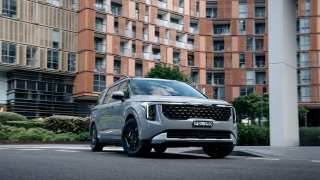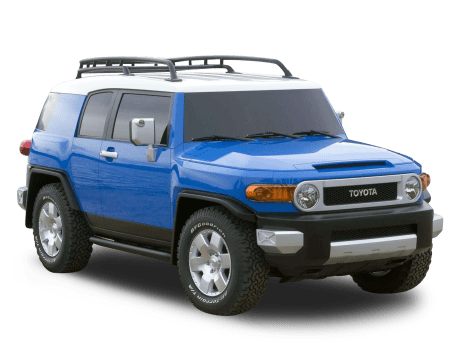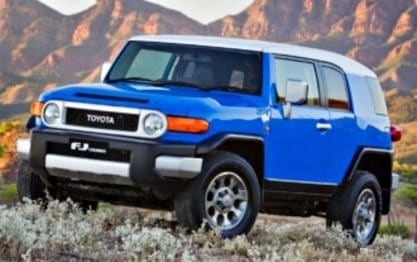
Toyota FJ Cruiser 2011 review: road test
- Toyota FJ Cruiser
- Toyota FJ Cruiser 2011
- Toyota FJ Cruiser Reviews
- Toyota Reviews
- Toyota SUV Range
- SUV
- Toyota
- Off road
- Family Cars
The FJ Cruiser is more than a distinctive face in today's herd of four-wheel drives. For not only does the FJ pay homage to the original FJ LandCruiser of the 1960s through to the 1980s it is also an honest off-roader. Loaded with style and some faded memories.
The FJ began life as a Californian styling exercise, Toyota looking to find more market appeal among younger buyers. By 2003 there was a concept, the Rugged Youth Utility, and by 2005 a production version launched into the United States.
There are three heroes here: exterior designer Jin Kim, interior designer Bill Chergosky and chief engineer Akio Nishimura. The three worked in unison to keep the FJ simple, stay true to the tradition of that iconic original and Kim's original vision; there were few compromises between concept and production.

Explore the 2011 Toyota FJ Cruiser range
That's resulted in a good-looking machine with many practical touches, few electronic do-dads and a fair swag of off-road ability. For Toyota this is the 'go anywhere, do anything' machine designed to attract younger, active lifestylers and at a more than reasonable price.
VALUE
At $44,990, the FJ is Toyota Australia's most affordable 'proper' four-wheel drive wagon. It is $500 dearer than the all-road Kluger and $11,000 cheaper than the three-door Prado, probably its closest competition.
A four-door, hardtop Jeep Wrangler starts at $40,990 and has the advantage of petrol and diesel powerplants, manual and automatic transmissions; a two-door Wrangler starts at $31,590 but can't offer as much room and on-road comfort as the FJ.
The new-boy Toyota - one model grade only - arrives with electric windows, air conditioning, six-stacker CD player with USB, iPod and Bluetooth connectivity, a rear-view camera and rear parking sensors. The floor is covered in a rubber-like compound, and the five seats are water-repellent; value-added material in an adventure machine.
TECHNOLOGY
Toyota has eschewed many of today's electronic driver aids for the FJ, citing the need to keep the machine honest, more onus on driver ability. But not offering multi-terrain settings and hill descent controls and such is also in keeping with the brief to keep the wagon affordable.
Instead what's here is the smooth four litre V6 petrol engine and five-speed automatic transmission (both borrowed from the Prado), a two-speed transfer case, a lockable rear differential, vehicle stability control and traction control, all packaged in and around a shortened Prado platform.
There are no plans at this stage for a diesel engine and there's a 20kg load limit on the front bumper, limiting the use of big bull bars and winches. Apparently testing weights hanging off the front of the chassis rails (a different construction to Prado) to Toyota standards would have taken too long and stymied its Australian introduction; this matter may be left to the aftermarket crowd.
DESIGN
Designer Jin Kim drew heavily on the original design. (That and an American pit bull with its chunky, forward-leaning stance.) An original FJ sat in the studio as Kim worked though he was after its essence, its DNA rather than a retro design.
So the FJ has round headlights, a mesh grille with Toyota badge (rather than the corporate bull horns) an upright windscreen, two-door style (with clever rear access doors), white roof and wrap-around rear windows. It also sits on tall rubber and 17-inch wheels. All this colours the FJ with yesteryear hints, adopted and adapted into an aggressive 21st century stance.
"It looks very serious, purposeful, indestructible," says Kim. "At the same time it looks fun. It is balancing all the opposing elements - serious playfulness."
Retro-inspirations are carried through to the cabin, a wide and spacious affair up front; roomy but cosy in the rear seat. The speedometer is painted up like the original, there are body-coloured panels, and big, chunky door handles and such.
It is a substantial vehicle and attention to what went before enhances the FJ's off-road and weekend adventure credentials - the big wheels add ground clearance, short front and rear overhangs make for better approach and departure angles, a hose-out interior should make cabins easier to clean while big controls makes it easier to find the right settings.
SAFETY
Passive safety features include six airbags and active head rests on the front seats. There's good visibility to the front and sides and, where compromised by the rear-mounted spare wheel, there's a rear view camera.
Clever B pillars are incorporated into the forward-opening, rear access doors. Active safety features include switchable traction control, stability control and ABS with electronic brake force distribution and brake assist.
Just as importantly for safer driving, the FJ's suspension and steering were tuned for Australian conditions over 100,000km of testing.
DRIVING
This is a comfortable and competent machine, on and off the road. The experience begins with that wide, high and handsome cabin; from the get-go the FJ feels substantial. Controls and instruments are big and easily identified, no hunting for miniature controls or worried something's about to break off.
Down the tar the first thought is the steering response a little remote but after a day, and particularly in the rough, it is familiar and well-weighted. (Toyota engineers suggest off-road feel was more the priority here.) Ride quality is impressive, the FJ rarely loses composure on bitumen or dirt.
The big V6 is smooth, nicely mated to the five-speed auto with plenty of punch for a 1955kg wagon. It runs easy to the maximum 200kW at 5600rpm and, with 310Nm of torque from 1200 rpm (lifting to 380Nm at 4400rpm), highway cruising and overtaking are never an issue.
Those torque figures also translate well to off-roading. Where some may dismay the lack of a diesel, this engine and transmission acquit themselves well when the going gets slow. Low-low range is more than adequate for an auto and there's good engine response for the quicker parts of the track.
And off-road those big and proper 17-inch wheels, short overhangs front and rear, good ground clearance and a wheelbase that allows for good ramp-over angles are complemented - where needed - by the lockable rear diff and Toyota's Active Traction Control, a switchable traction system to control wheel slip. Yet for the most of it, the FJ will go a long way before these aids may be needed.
VERDICT
The Toyota FJ Cruiser is one of those rare cases where form and function mesh into a most stylish machine with real off-road credentials. The lack of a diesel engine may inhibit sales but will not inhibit the FJ's status as a hero machine in the Toyota fleet.
Pricing guides
Range and Specs
| Vehicle | Specs | Price* | |
|---|---|---|---|
| (base) | 4.0L, PULP, 5 SP AUTO | $18,370 – 23,320 | 2011 Toyota FJ Cruiser 2011 (base) Pricing and Specs |
$25,990
Lowest price, based on 18 car listings in the last 6 months







